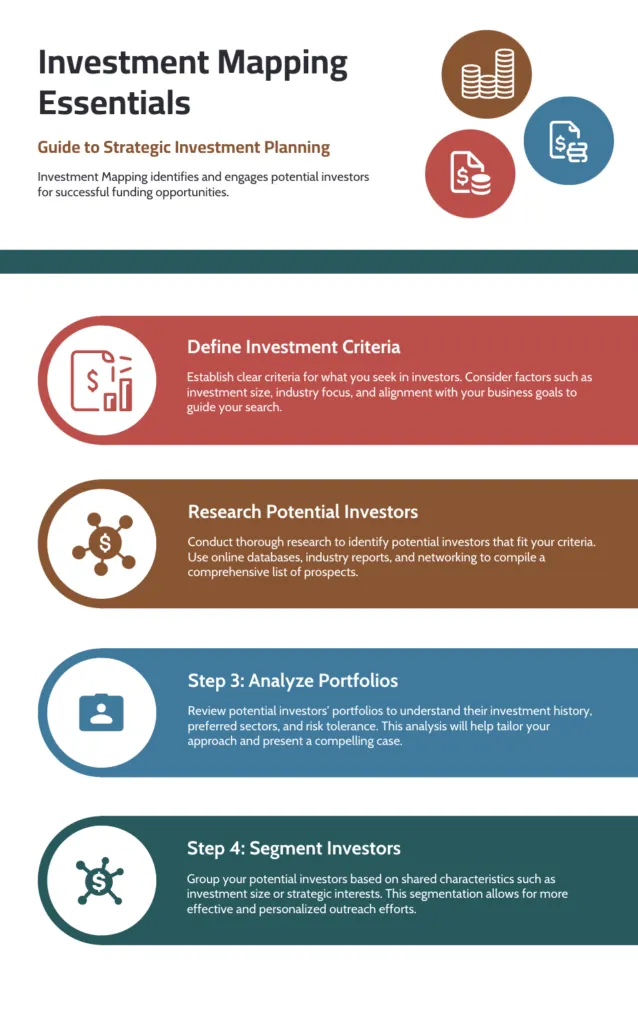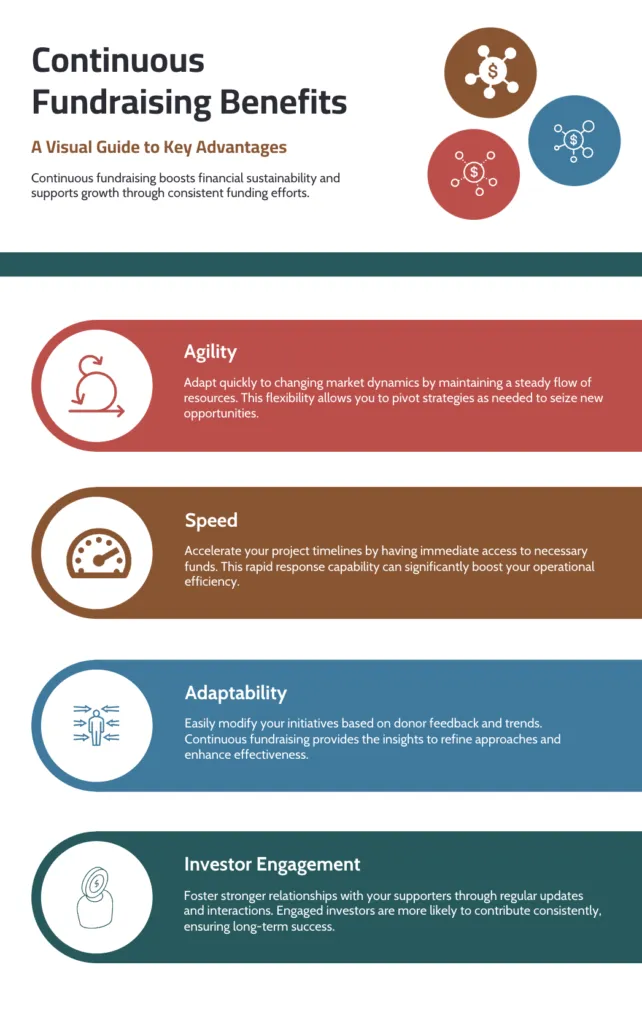Investors offer not only funding but also expertise, networks, and credibility that can accelerate your company’s growth. For entrepreneurs and business professionals, understanding how to cultivate these investment relationships is fundamental.
Effective investor relationship management sets your business apart, leading to ongoing support and valuable strategic advice.
Yet, many businesses face challenges in building these relationships. Managing investor expectations, overcoming cultural differences, and maintaining engagement over time require advanced strategies.
This guide provides actionable insights, practical tools, and examples to help you build and strengthen relationships with investors—whether you’re seeking initial funding or aiming to enhance ongoing investor relations.
For foundational insights on investor engagement, explore our guide on Investor Outreach Strategies.
Understanding Investor Motivations to Build Strong Relationships
To cultivate meaningful relationships with investors, first understand what drives their decisions. Investors assess more than your business model; they evaluate risks, potential returns, and how well your goals align with theirs.
Delving into Investor Decision-Making Processes
Investors often rely on both rational analysis and emotional intuition. Recognizing these processes enhances your ability to connect with investors effectively.
- Analytical Evaluation: Investors examine financial performance, market potential, and competitive advantage. They’ll scrutinize your business plan, financial statements, and projections.
- Emotional Connection: Trust in the leadership team and belief in the company’s mission significantly influence decisions. Building an emotional connection goes beyond numbers—it’s about fostering confidence and rapport.
Factors Influencing Investment Decisions
Several elements impact where investors choose to allocate their capital:
- Market Trends: Alignment with burgeoning industries can enhance your appeal.
- Unique Value Proposition: Clearly differentiating from competitors is essential.
- Team Expertise: Demonstrating a skilled and experienced team instills confidence in your ability to succeed.
Aligning Your Goals with Investor Expectations
Successful investment relationships stem from mutual alignment. Ensure your business objectives resonate with what investors seek:
- Shared Mission and Vision: Investors often prefer companies whose missions align with their values and investment philosophies.
- Transparent Financial Goals: Be open about your financial objectives to match investor expectations.
- Clear Growth Strategy: Present a well-defined plan for scaling your business and achieving milestones.
Insights into Investor Psychology
Understanding investor psychology can give you a competitive edge:
- Behavioral Finance Concepts: Recognize cognitive biases like overconfidence or loss aversion that influence investor behavior.
- Emotional Triggers: Craft narratives that connect emotionally, appealing to investors’ desires and concerns.
- Trust Building: Establishing a reputation for honesty and reliability is crucial.
Case Study: Aligning with Investor Values
A tech startup focused on renewable energy secured funding by aligning its mission with sustainability-focused investors. By emphasizing environmental impact and long-term market potential, they tapped into investors’ desire to contribute to meaningful change while achieving financial returns.
For strategies on building trust with potential investors, explore our guide on building trust with potential investors.
Understanding investor psychology is key to crafting a compelling narrative. Discover advanced techniques in mastering investor communication to connect emotionally with your audience.
Clear and Compelling Communication Strategies for Investor Relations
Effective communication is the cornerstone of strong investment relationships. Crafting a compelling narrative and conveying your message with clarity can significantly influence investor engagement.
Crafting an Engaging Corporate Narrative
Your corporate narrative should tell a story that resonates with investors on both rational and emotional levels.
- Utilize Storytelling Frameworks: Use structures like the Hero’s Journey or Problem-Solution-Benefit models to shape your narrative.
- Highlight Impact: Emphasize the problem you’re solving and the positive effects of your solution on customers and the industry.
- Be Authentic: Genuine communication builds credibility and trust.
Applying Storytelling Techniques
Stories linger in people’s minds longer than statistics alone.
- Start with a Hook: Begin with a compelling opening that captures attention.
- Share Real-Life Examples: Use success stories or testimonials to illustrate your company’s value.
- Incorporate Visuals: Enhance your storytelling with infographics or videos.
Tailoring Messages to Diverse Investor Groups
Different investors have varied priorities and interests.
- Institutional vs. Individual Investors: Institutions may focus on scalability, while individuals might value innovation and personal connections.
- Cultural Sensitivities: Be mindful of cultural nuances when communicating with international investors.
- Investment Stages: Adjust your message according to the investment stage—seed funding, Series A, etc.
Best Practices for Clear and Transparent Communication
- Maintain Clarity: Avoid jargon; use straightforward language.
- Ensure Consistency: Keep your message consistent across all platforms and communications.
- Practice Transparency: Be open about challenges and how you plan to address them.
Templates for Effective Communication
Consider using templates to structure pitch decks, executive summaries, and investor updates. Templates ensure all critical information is included and presented coherently.
For insights on engaging investors through social media, check out our article on leveraging social media to engage potential investors.
To explore broader investor outreach strategies, visit our resource on investor outreach strategies.
Building Trust with Investors through Transparency and Honesty
Trust is the foundation of any strong relationship with investors. Demonstrating transparency and honesty can significantly enhance investor confidence.
The Importance of Transparency in Investor Relations
Transparency fosters trust and reduces uncertainty.
- Open Communication: Share both successes and setbacks openly.
- Accessible Information: Provide investors with access to financial reports, performance metrics, and strategic plans.
- Regular Updates: Keep investors informed about progress, challenges, and future plans.
Strategies for Building and Maintaining Trust
- Set Realistic Expectations: Align expectations with achievable goals.
- Deliver Consistently: Meet or exceed your commitments.
- Operate with Integrity: Uphold ethical standards in all business practices.
Communicating Challenges Effectively
Every business faces obstacles. How you communicate during tough times can strengthen or weaken investor relationships.
- Timely Updates: Address issues promptly before investors hear from other sources.
- Provide Solutions: Present a plan to address problems when discussing them.
- Maintain Confidence: Acknowledge challenges without appearing defeated.
Fostering Long-Term Relationships
Building trust is a continuous process.
- Consistent Engagement: Maintain regular contact, even when not seeking additional funding.
- Show Appreciation: Recognize and thank investors for their support.
- Encourage Collaboration: Involve investors in strategic discussions when appropriate.
Example: Effective Expectation Management
A biotech company faced delays in clinical trials. By proactively communicating the reasons, outlining steps to expedite the process, and adjusting timelines, they maintained investor trust and continued support.
Managing expectations is crucial in fostering long-term relationships. For more on keeping investor relationships strong after securing funding, read our guide on keeping investor relationships strong after securing funding.
Regular and Effective Communication to Strengthen Investor Relationships
Consistent communication keeps investors engaged and reinforces their confidence in your business.
Establishing a Communication Schedule
Regular updates demonstrate professionalism and respect for your investors.
- Quarterly Reports: Provide detailed updates on financials, milestones, and projections.
- Monthly Newsletters: Share highlights, achievements, and upcoming initiatives.
- Annual Meetings: Host sessions to discuss long-term strategies.
Choosing Preferred Communication Channels
Understanding your investors’ preferred methods enhances engagement.
- Emails: Efficient for formal updates and reports.
- Virtual Meetings: Facilitate interactive discussions regardless of location.
- Investor Portals: Offer secure access to documents and updates.
- Professional Networks: Engage through platforms like LinkedIn.
Sharing Updates on Performance and Milestones
Keeping investors informed about your progress is essential.
- Financial Health: Share key metrics and indicators.
- Achievements: Highlight product launches, partnerships, or market expansions.
- Challenges and Solutions: Be transparent about obstacles and how you’re addressing them.
Techniques to Keep Investors Engaged
- Personalized Messages: Address investors by name, tailoring content to their interests.
- Interactive Content: Use videos, webinars, or interactive reports.
- Encourage Feedback: Invite investors to share input and ask questions.
When discussing engagement methods, consider networking at industry events to strengthen relationships. Learn more about maximizing your impact in our article on networking at industry events.
Using Technology to Enhance Investor Relations
In today’s digital age, technology plays a vital role in improving investor communication and engagement.
Enhancing Investor Relations with Technology
- Increase Efficiency: Automate routine communications and reporting.
- Improve Accessibility: Provide real-time access to information through online platforms.
- Boost Engagement: Use interactive tools to keep investors informed and involved.
Key Tools and Platforms
- Investor Relations Management Software: Streamlines communication and document sharing.
- Webinars and Virtual Meetings: Facilitate discussions regardless of location.
- Data Analytics Tools: Offer insights into investor behaviors and preferences.
- Secure Portals: Centralize access to reports, updates, and important documents.
For a detailed exploration of effective tools, visit our guide on best tools and technologies for improving investor relations.
Cultural Considerations in Building Investor Relationships
As businesses globalize, understanding cultural nuances becomes essential for effective investor relations.
Impact of Cultural Differences on Communication
Cultural variations can influence:
- Communication Styles: Directness, formality, and context vary widely.
- Business Etiquette: Expectations around meetings and negotiations differ.
- Relationship Building: Some cultures prioritize personal relationships over business agendas.
Strategies for Cross-Cultural Engagement
- Research Thoroughly: Understand the cultural background of your investors.
- Invest in Training: Provide cultural sensitivity training for your team.
- Partner Locally: Collaborate with local experts or advisors.
Adapting Communication Styles
- Mind Language Barriers: Use professional translation services when necessary.
- Adjust Content: Tailor messages to align with cultural values.
- Show Respect: Appreciate cultural practices and avoid assumptions.
Case Study: Successful International Partnerships
A manufacturing company expanded its investor base internationally. By adapting their communication style and engaging local advisors, they secured investments from multiple countries, fueling global growth.
For more on navigating cultural differences in investor relations, read our article on global investor engagement: navigating cultural differences.
Personalization Techniques to Engage Investors
Personalization enhances engagement by making investors feel valued and understood.
Understanding Individual Investor Preferences
- Investment Goals: Know whether investors prioritize short-term gains or long-term growth.
- Communication Style: Some prefer detailed reports; others appreciate high-level summaries.
- Values and Interests: Align messaging with what matters to them, such as sustainability or innovation.
Tailoring Communication Strategies
- Customized Reports: Provide information highlighting areas of interest to each investor.
- One-on-One Meetings: Address specific concerns or opportunities individually.
- Exclusive Access: Offer early insights into developments or special events.
The Role of Personalization in Building Strong Relationships
- Strengthen Trust: Personalized interactions show you value the investor beyond their capital.
- Enhance Satisfaction: Tailored communication meets their needs effectively.
- Drive Loyalty: Investors are more likely to support businesses that recognize their preferences.
Successful Personalization Efforts
A retail company segmented investor updates based on interests—sending detailed product news to innovation-focused investors and market expansion updates to those interested in growth. This approach increased engagement and satisfaction.
For strategies on building trust with potential investors, visit our guide on building trust with potential investors.
Engaging Investors Early and Continuously
Engaging with investors early and maintaining that engagement fosters strong relationships.
The Significance of Early Engagement
- Build Rapport: Establish relationships before financial commitments.
- Understand Expectations: Align goals from the outset.
- Demonstrate Commitment: Show you value the partnership beyond funding.
Maintaining Continuous Engagement
- Regular Updates: Keep investors informed consistently.
- Active Communication: Encourage open and ongoing dialogue.
- Adapt Over Time: Adjust strategies as the relationship evolves.
Develop a robust network to enhance early engagement strategies by exploring our tips on developing a robust investor network.
Case Studies and Examples
Learning from similar scenarios provides valuable insights into effective investor relationship management.
Success Stories of Effective Investor Relationships
Tech Startup’s Transparent Communication
A tech startup faced setbacks in product development. By maintaining transparent communication, providing regular updates, and demonstrating a recovery plan, they retained investor confidence and secured additional funding.
Manufacturing Company’s Cross-Cultural Success
A manufacturing firm sought international investors for global expansion. By respecting cultural differences and engaging local advisors, they secured investments from multiple countries, fueling growth.
Lessons from Challenges in Investor Relations
Retailer’s Mismanaged Expectations
A retailer overpromised on growth projections, leading to investor dissatisfaction when targets weren’t met. The lack of transparent communication strained relationships and resulted in lost support, highlighting the need for realistic goal-setting.
Industry-Specific Examples
- Healthcare: A biotech firm enhanced engagement by tailoring updates to investors’ scientific understanding.
- Renewable Energy: An energy startup built strong relationships by aligning its mission with environmentally conscious investors.
Conclusion
Building strong relationships with investors requires understanding their motivations, communicating effectively, and fostering trust through transparency and personalization. By applying these strategies, you can enhance your investor relations, leading to sustained success for your business.
Remember to:
- Understand Investor Psychology: Align your approach with investor motivations.
- Communicate Clearly: Craft narratives that resonate and maintain transparency.
- Build Trust: Uphold honesty and integrity in all interactions.
- Personalize Engagement: Tailor communication to individual preferences.
- Respect Cultural Nuances: Adapt strategies to honor cultural differences.
Enhance your investor relations efforts with Qubit Capital’s expert solutions. Our team is dedicated to providing innovative insights and practical tools to help you build lasting connections with investors.
For comprehensive strategies on investor outreach and relations, explore our super pillar article on Investor Outreach and Relations.
Key Takeaways
- Understand Investor Motivations: Align your business goals with what investors seek, considering both rational analysis and emotional connections.
- Communicate Effectively: Use clear, authentic storytelling to convey your message and engage investors.
- Build Trust Through Transparency: Be honest and open in all communications, especially during challenges.
- Maintain Regular Engagement: Establish consistent communication schedules and use preferred channels to keep investors informed.
- Personalize Interactions: Tailor your communication strategies to individual investor preferences to enhance engagement.
- Use Technology Wisely: Implement tools and platforms to improve efficiency and accessibility in investor relations.
- Respect Cultural Differences: Adapt your approach to accommodate cultural nuances, fostering stronger international relationships.
- Engage Early and Continuously: Begin building relationships before seeking funding and maintain engagement over time.
Frequently Asked Questions (FAQ)
1. How do you establish a relationship with an investor?
- Answer:
- Identify Aligned Investors: Research investors whose interests align with your business.
- Engage Through Multiple Channels: Attend networking events, seek referrals, and reach out directly.
- Demonstrate Value: Present a compelling pitch highlighting your unique value proposition.
- Maintain Transparency: Build trust through honest communication.
- For detailed strategies, see our guide on developing a robust investor network.
2. What are the best practices for investor relations?
- Answer:
- Maintain Transparent Communication: Keep investors informed regularly.
- Understand Their Motivations: Align your goals with investor expectations.
- Personalize Engagement: Tailor interactions based on individual preferences.
- Use Technology Effectively: Implement tools to improve efficiency.
- Explore more in our article on best practices for investor relations.
3. How do you keep investors satisfied?
- Answer:
- Provide Regular Updates: Share progress and milestones candidly.
- Deliver Consistently: Meet or exceed expectations.
- Involve Investors: Engage them in key developments.
- Address Concerns Promptly: Be responsive and proactive.
- Learn techniques in keeping investor relationships strong after securing funding.
4. Why is investor relationship management important?
- Answer:
- Fosters Trust and Loyalty: Leads to sustained support.
- Access to Additional Funding: Strong relationships can ease future capital access.
- Valuable Advice and Networks: Investors offer strategic guidance and connections.
- Enhances Reputation: Effective management builds credibility.


 Back
Back




























